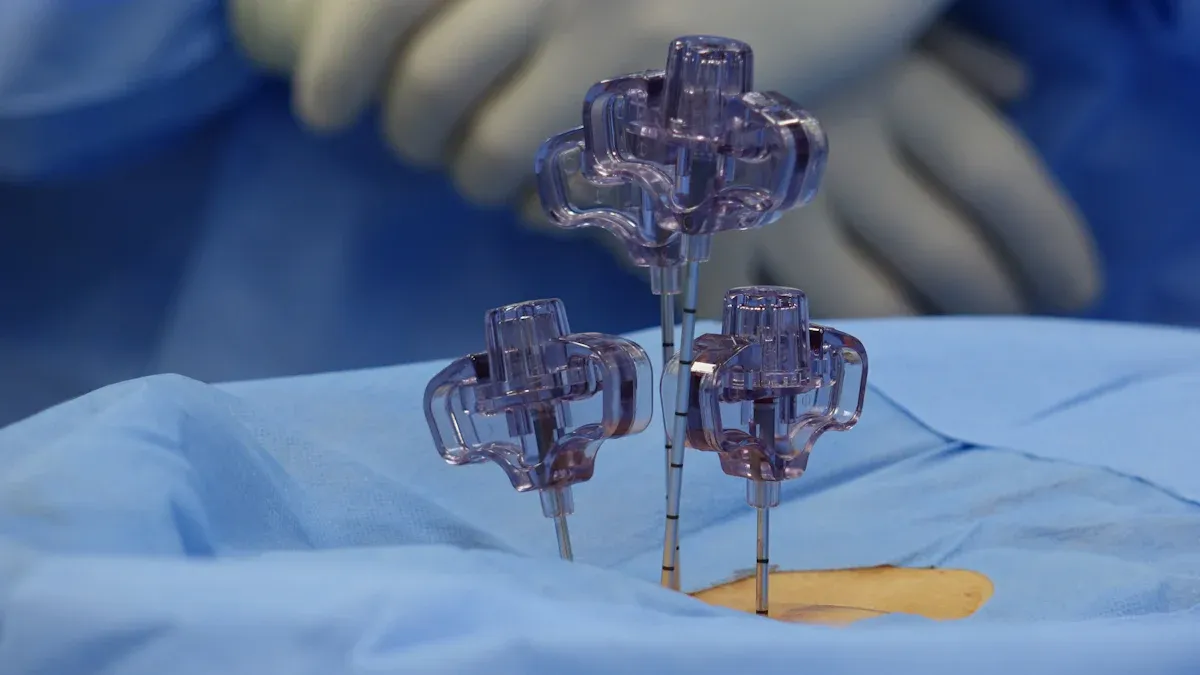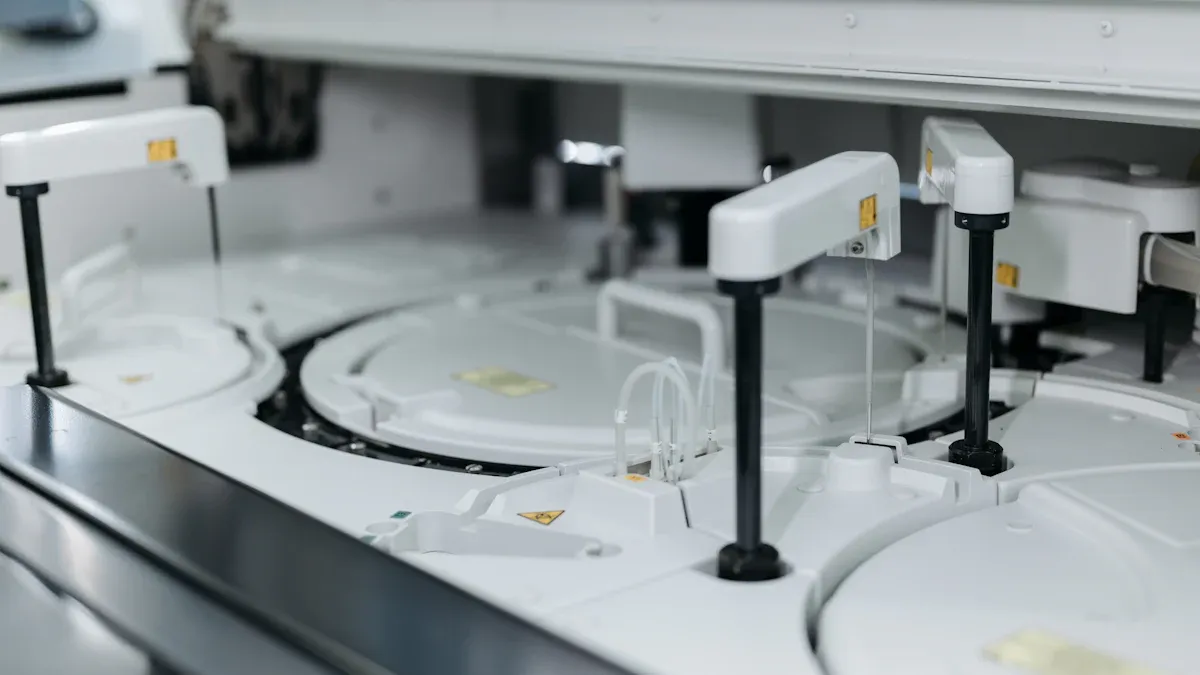Apr.
01, 2025
Contents
Common Materials Used in High-Precision Industrial Parts
The Role of Precision Machining in Medical Devices
Benefits of Precision Machining for Medical Devices
Tools and Technologies in Precision Machining
Quality Control in Precision Machining
Innovations and Future Trends in Precision Machining

Precision machining is very important for improving medical technology. It helps make parts with great accuracy, so devices work well during important procedures. CNC machining, for example, reduces mistakes and keeps parts precise, lowering the chance of device problems. This makes patients safer.
Tests showed the new process worked as well as the old one. This is important for manufacturers to gain trust from OEMs in the process.
The global medical device market was worth $516.7 billion in 2022. It keeps growing because of older populations and better healthcare. Precision machining helps this growth by supporting new ideas and making devices reliable.
Precision machining helps medical devices meet very high accuracy standards. These devices must work perfectly, especially during important procedures. For example, surgical tools and implants need to be very exact. Even a small mistake in a part can ruin the device and risk lives.
Modern CNC machines make parts that match 3D models exactly. They reduce errors to tiny levels, even as small as microns. This accuracy makes surgeries safer and improves diagnostic tools. It also lowers waste and raises the quality of medical devices.
Smaller and portable medical devices are becoming more popular. Precision machining helps engineers solve problems with size and weight. This means you get devices that are small but still work well. For example, portable monitors let patients recover at home instead of staying in the hospital.
Advanced machining creates detailed designs and tiny parts. Engineers use special materials to make electronics smaller but still strong. Every part of a device, inside and out, is made for small size. This keeps devices useful and high-quality as needs change.
Many medical devices today are made possible by precision machining. Surgical tools like scalpels and forceps need exact manufacturing to work well. Implants, such as artificial joints and dental crowns, must fit perfectly to last long.
Diagnostic tools, like MRI machines and portable ultrasounds, also use precision machining. These tools have many complex parts that must work together smoothly. Precision machining allows these parts to be made, improving modern medical technology.
Precision machining helps medical devices work better and safer. These devices meet strict rules to ensure they work properly. For example, it makes implants and tools fit and work well.
Machines with many moving parts make complex shapes more accurately. They also remove more material faster, saving time. This means devices are made quicker without losing quality.
Metric Description Precision and Accuracy Important for meeting strict rules, keeping devices safe and useful. Repeatability Ensures devices are made the same every time, helping patients. Reduced Production Time Speeds up making devices, meeting market needs faster.
These improvements help patients heal faster and save time in surgeries.
Medical devices need to last through many uses without breaking. Precision machining uses strong materials and careful work to make durable parts. This makes devices last longer and work better.
Benefit Description Enhanced Precision Makes devices fit better and work more accurately. Better Surface Finishes Creates smoother surfaces for improved device performance.
Advanced tools make smoother and stronger parts. These parts wear out less, making devices last longer and cost less to replace.
Every patient is different, so their devices should fit them. Precision machining makes custom devices like prosthetics or implants that fit perfectly. This improves comfort and helps patients recover better.
It also allows using many types of materials to meet medical needs. This flexibility helps create devices that work well for each patient.
Metric Description Flexibility in Material Choice Lets manufacturers use different materials for medical needs. Customization Makes devices fit patients better, improving comfort and healing.
Precision machining combines accuracy and flexibility to improve patient care.

CNC machining is key to making accurate medical device parts. It uses computers to guide tools, shaping materials with great precision. CNC machines create parts that match exact designs, ensuring devices work properly.
A big benefit of CNC machining is saving time and reducing waste. SPC (Statistical Process Control) checks the process in real-time. This fixes problems quickly, keeping quality high.
Metric Traditional Machining Advanced CNC Machining Cycle Time Longer Much Shorter Material Waste More Very Little Energy Use Higher Lower Production Cost Expensive Cheaper
These features make CNC machining vital for making implants and surgical tools.
Laser cutting and micro-machining have changed how devices are made. These methods allow for detailed designs with high accuracy. For example, laser cutting makes parts fit perfectly, lowering failure risks. Micromachining creates tiny features like small holes and channels, which are important for devices to work.
Lasers provide precise and flexible solutions for complex shapes.
Micromachining repeats results, making it great for mass production.
Ultrafast lasers skip extra steps, making production faster.
These technologies improve device quality and speed up production. They are used in items like stents and catheters, where precision matters most.
The materials used affect how well medical devices perform. Strong materials like titanium and stainless steel are common because they are safe for the body. But these materials are hard to shape. Precision machining handles them carefully without losing quality.
Metals like titanium and stainless steel are strong and reliable.
Polymers like PEEK act like natural tissue, great for implants.
Precision machining makes detailed plastic parts with great accuracy.
Using these materials helps create safe and durable devices. The need for precise parts keeps pushing new ideas in this field.
Precision machining needs strict tolerances to make safe devices. Tolerances as small as 0.002 mm are often required. Even tiny errors can make parts useless and unsafe for patients. Rules like ISO 1101 and ASME Y14.5 set these tolerances to keep parts consistent.
Medical devices need tolerances for shape, position, and alignment. For example, implants must fit the body perfectly to avoid problems. By following these rules, manufacturers create reliable parts for modern healthcare needs.
Checking and testing are important to keep quality high. Manufacturers use tools like control charts and SPC to watch production. These tools find problems early, reducing mistakes and keeping quality steady.
Important checks include precision, material safety, and smooth surfaces. For example, CNC machines must work within ±0.0001 inches using materials like titanium. Surfaces must also be smooth to stop bacteria from growing. Keeping detailed records ensures rules are followed and parts can be traced.
Metric Description Precision and Material Safety Keeps tight tolerances and works with medical-safe materials. Smooth Surface Quality Makes surfaces safe and stops bacteria growth. Records and Traceability Tracks results to meet rules and stay accountable.
Following rules is key in making medical device parts. Standards like ISO 13485 and FDA rules ensure high-quality processes. These rules require strong quality systems and constant improvements.
Steps include managing risks, testing, and checking processes. For example, manufacturers test machining steps to ensure parts are always high quality. They also use advanced tools like automation to improve accuracy. By following these rules, manufacturers make devices that are safe and work well for patients.
Compliance Practice Description Quality Systems Keeps processes in line with important rules. Constant Improvements Updates processes to meet new needs. Advanced Tools Makes parts more accurate and reduces mistakes.
AI and automation are changing how medical devices are made. AI finds equipment problems early, cutting downtime and repair costs. It also improves workflows, helping production meet market needs. For example, AI checks images of parts to spot defects, improving quality.
Automation handles simple tasks faster, letting workers do harder jobs. Robots boost productivity by managing tasks like moving materials and assembly. AI-powered tools predict machine issues, keeping production running smoothly. These changes make better devices with fewer recalls, helping patients.
3D printing is changing how medical devices are created. It allows for custom designs made just for each patient. Combining 3D printing with regular machining improves how devices are made. This ensures they meet strict quality and precision standards.
Benefit Description Better Results Combines old and new methods for improved outcomes. Custom Designs Makes devices fit patients perfectly for better results. High Quality Ensures devices follow strict medical rules.
3D printing makes detailed designs quickly, helping modern healthcare. It supports the need for personalized devices, improving patient care and satisfaction.
New materials are expanding what precision machining can do. Polymers like PEEK and PAEK are popular for their special features. PEEK is strong and acts like bone, making it great for implants. PEKK, a type of PAEK, helps implants work even better.
These materials are safe for the body and last a long time. New biocompatible materials are making devices safer and more effective. As material science improves, even more exciting medical advances will come.
Precision machining is key to making medical devices work well. It helps create detailed parts like implants using materials like PEEK. PEEK is strong and acts like real bone. This process makes devices last longer and reduces waste. CNC and multi-axis machines bring new ideas to device making. These changes improve patient care. For example, they help find problems 12.8–53.9% faster. They also lower pain from fixing devices.
Precision machining is a way to make very exact parts. It uses special machines like CNC tools to shape materials. This helps medical devices meet high-quality and safety rules.
Precision machining makes medical devices safe and reliable. It ensures parts fit well, work properly, and last a long time. It also helps create new and custom designs.
Materials like titanium, stainless steel, and PEEK are often used. Titanium and stainless steel are strong and durable. PEEK is like natural tissue, so it’s great for implants. These materials are safe and long-lasting.
Precision machining makes custom devices that fit each patient. This makes them more comfortable and helps them heal faster. Accurate tools and implants also make surgeries safer and better.
Yes! Precision machining works with new tech like AI, robots, and 3D printing. These tools help make better, smarter, and more personal medical devices. This improves healthcare for everyone.
Navigation
Navigation
Contact Us
Tel: +86 13417419143
E-mail: [email protected]
Add:
2nd Floor, Building 7, 156 High Tech Industrial Park, Fuyuan 1st Road, Zhancheng Community, Fuhai Street, Baoan District, Shenzhen City, China.